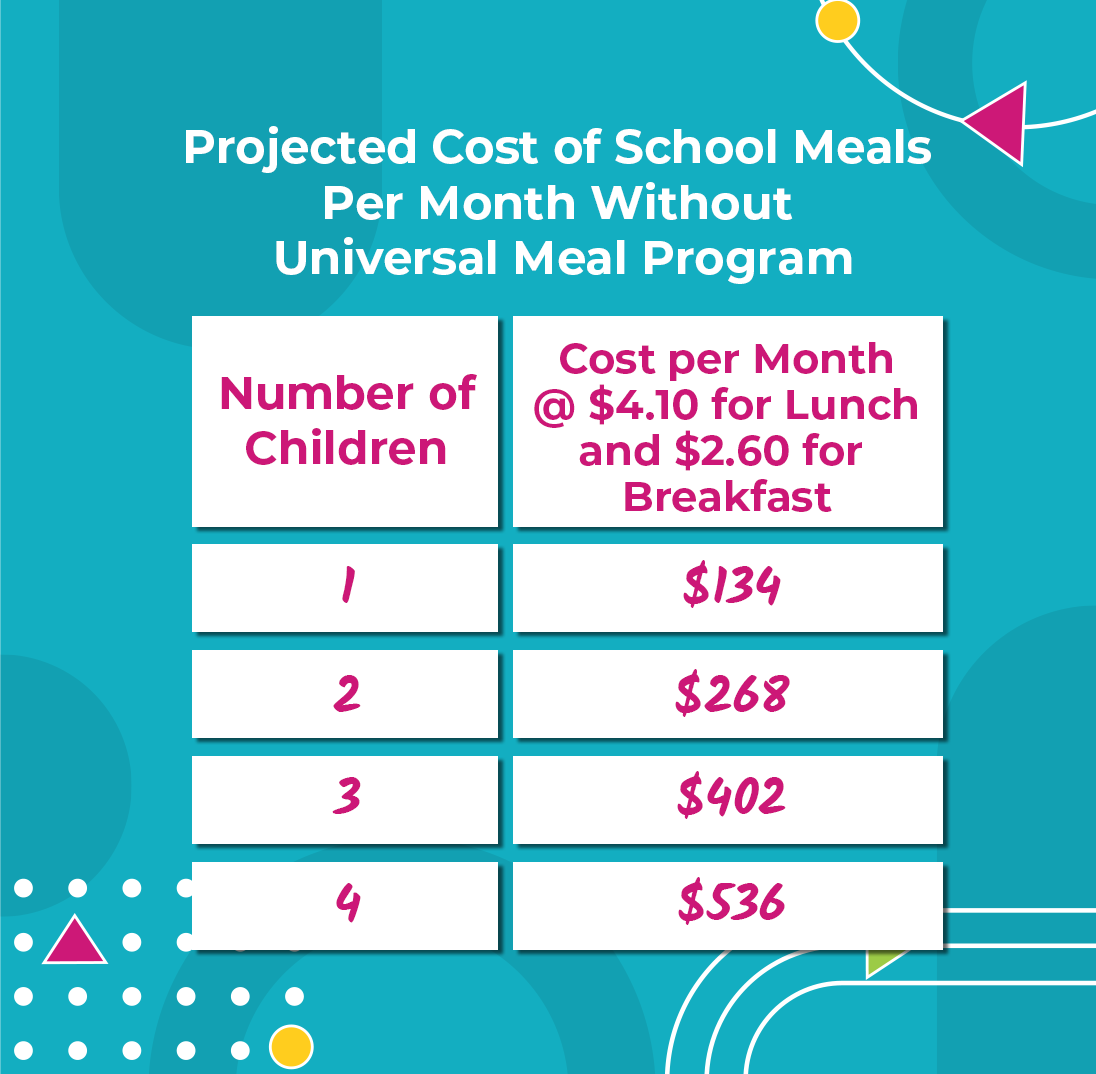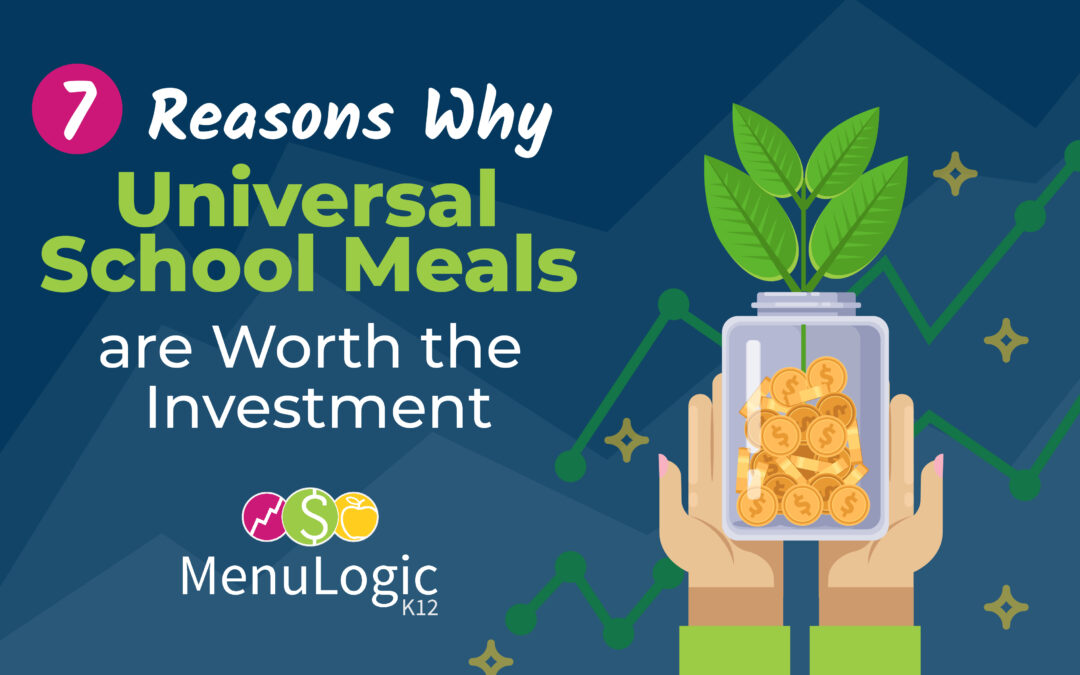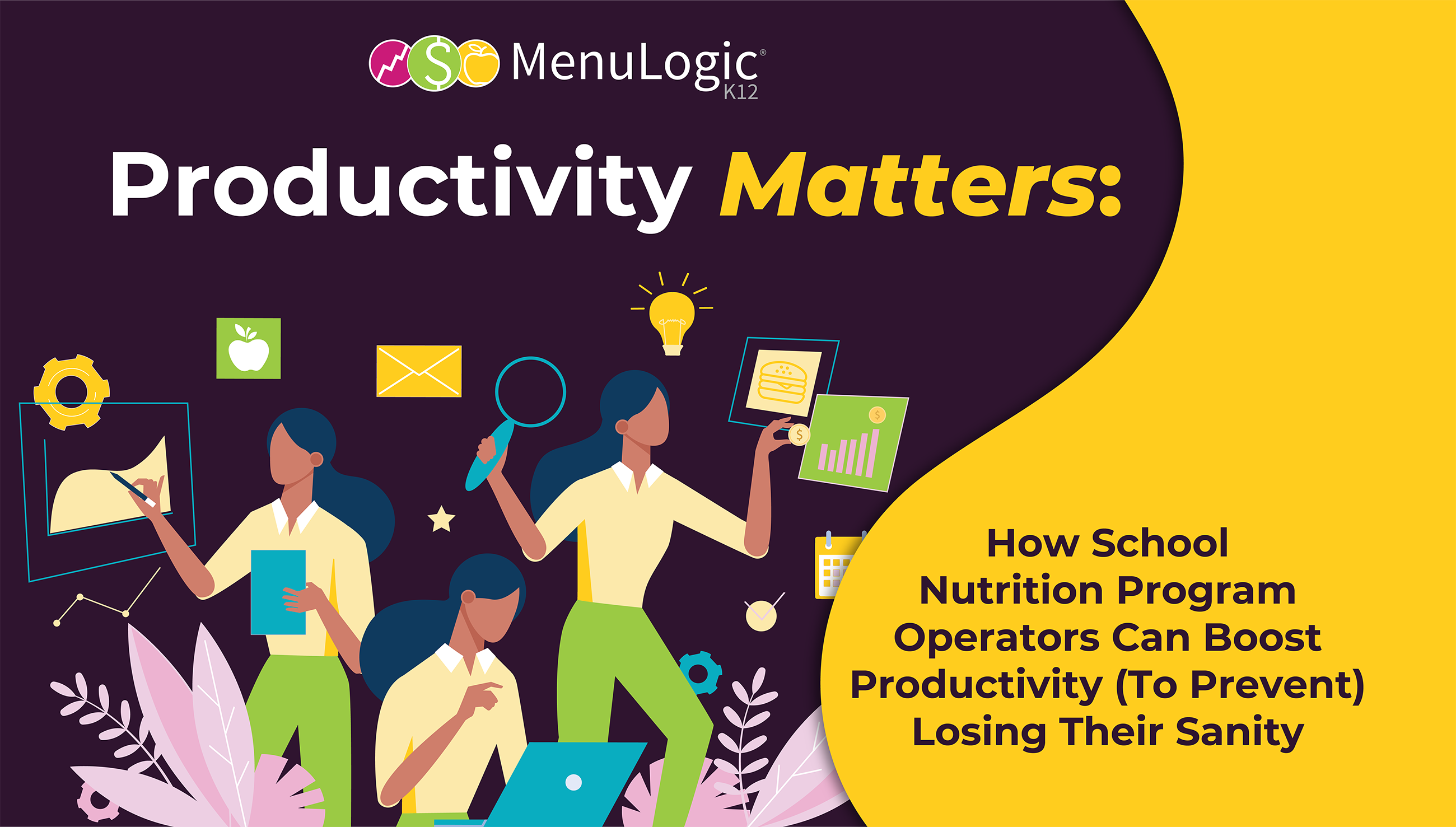7 Reasons Why Universal School Meals are Worth the Investment
The Benefits Reach Students, Families, and American Businesses
Universal school meals would mean a federal tax-funded program that makes breakfast and lunch available to all students regardless of their income. Right now, universal school meals are temporary. State and federal legislators are discussing bills that would implement these programs.
With that in mind, let’s play a game of true or false: Universal school meals only assist low-income families.
I’m a school nutrition director, a Registered Dietitian, and founder of MenuLogic K12 (a business intelligence software for school nutrition programs), so I’m well acquainted with the answer.
Answer:
FALSE- Universal school meals absolutely do assist low-income families. But they also benefit middle and upper-income families, school districts, and entire communities.
In fact, one 2021 study identified the following benefits of universal school meals:
- They have a protective effect on student BMI.
- They improve financial outcomes for school districts
- They’re associated with increased household incomes
The taxes you pay supporting a universal school meal program is money well-spent — they go directly to children, families, and domestic businesses. In other words, every tax dollar spent on universal school meals is a direct investment in your community.
I’m going to walk you through these 7 reasons why the benefits of a universal school nutrition program ripple from individual students to families and entire communities:
1. Gives families (and voters) what they want
2. Benefits families at ALL income levels
3. Helps children focus on school, not hunger (or stigma)
4. Meets kids’ nutritional needs
6. Lets school nutrition staff be community helpers (not debt collectors)
7. Is critical for the survival of school nutrition programs
The Business Case for Equitably-Funded (Universal) School Meals
First, some background for anyone who thinks our programs are already locally funded.
School nutrition programs are businesses. If you think of a school district as a small city, we’re your favorite franchise “restaurant” at every major intersection (and it’s our pleasure). The same school nutrition team manages all “restaurants” operating in a single district’s buildings. The money we make through purchased meals and a la carte items (snacks) pays for our food, supplies, equipment, and labor costs.
So no, taxpayers don’t fund our programs — at least not directly. State taxes fund the rest of the district, but (like a restaurant) we get our revenue from the money we earn.
Traditionally, our revenue comes from two sources: what families pay for meals and federal meal reimbursements. The amounts are determined by income guidelines that classify students into three categories: Free, Reduced, and Paid.
These classifications determine the amount that families pay for meals and the amount we are reimbursed for those meals. All meals are subsidized, including Paid. Free and Reduced meals give us the highest revenue because Paid meals are reimbursed at a substantially lower rate ($.42 vs $3.73 per lunch).
Enter a pandemic.
The USDA (our regulatory agency) created emergency waivers to offset the disruptions nutrition programs faced because of COVID closures and lockdowns. One of these waivers allows districts to offer meals at Free rates/reimbursements to ALL students.
The waiver came at a critical time for families impacted by COVID, and I’m grateful. It also came at a critical time for school nutrition programs because it gave us what we’ve always needed to be successful: equitably funded meals.
The socioeconomic status of our students and school district no longer mattered. Because of the temporary waiver, we don’t have to structure sales offerings based on our students’ household incomes to make ends meet.
Whether we like it or not, we must put effort into where we are funded. When meals are funded fairly and equitably, meals are our focus, not a la carte snacks and beverages.
Our reality is that this waiver is currently set to expire in June 2022. I’m happy to see a congressional push for increased access to school meals. But the Build Back Better Act isn’t enough and does not address the problem.
We need legislation that makes equitably-funded meals permanent. Here’s why.
1. Families Want School Lunches
According to the most recent federal data, the demand for Free or Reduced meals is growing:
- In 2019, schools served 74.1% of lunch meals at Free or Reduced rates.
- In 2020, that number increased to 76.9%.
- In 2021, 90% of meals were served at Free rates.
Families are increasingly eager to participate in school meal programs because school meals do a critical but difficult task:
They consistently provide ALL children with exceptional, nutritious, hot food.
2. Equitably-Funded School Meals Benefit Families at ALL Income Levels
If passed, the Build Back Better Act would expand eligibility for free meals through CEP (Community Eligibility Provision).
That’s not nearly enough to solve the problems school nutrition programs face.
The CEP targets school districts at the lowest socioeconomic level. It doesn’t impact districts with a higher number of Paid-eligible students (students in households with incomes too high for Free or Reduced rates).
But here’s the thing:
Most Paid-eligible students aren’t the uber-wealthy. They’re middle-class families selling trash bags and wrapping paper to fundraise for their kids’ extracurriculars.
It’s a huge mistake to think those families don’t want (or won’t benefit from) equitably-funded meals, and I’ve seen numbers proving that.
Meal participation grew by 20% and more in many districts after COVID, and those increases came from Paid-eligible students. In other words, families that made too much to qualify for Free or Reduced rates were finally able to participate in their school’s meal program when the emergency waiver kicked in. That tells me that cost, not preference, kept them out of our programs.
When the waiver expires, we have to start charging those parents again.
To serve Free and Reduced-eligible students, we need the revenue from Paid-eligible students. But increases in food, labor, and supply costs will force us to charge rates that price us out of the market.
Will Paid families be able to afford or choose to put our programs back into their household budgets?
3. Equitably Funded Meals Help Children Focus on School (Not Hunger or Stigma)
Every child deserves to wake up knowing they’re going to eat that day, but that’s not our reality. Some caregivers forget to pay, some can’t pay, and some choose not to pay for their student’s meals.
Our cashiers serve hundreds of students in less than 7 minutes in a typical lunch line. That leaves 5-10 seconds per transaction. When a student’s account is unpaid, the reason doesn’t change the outcome: a child staring up at a cashier with an empty belly and no means to fill it.
How can that embarrassed student and guilty cashier handle this situation appropriately within such tight time constraints? What other restaurant in the country can serve food that quickly AND gently explain to hungry six-year-olds that they still need to pay for their food?
A walk in the shoes of a student juggling hunger, anxiety, and school work would help us understand certain behavioral issues that come up in the classroom. It’s tough to practice long division when you’re worried you won’t have enough money in your account to eat lunch.
Can you imagine the impact on our kids’ education when they no longer worry about hunger and payment logistics?
Don’t we prefer parents spend their time engaging with the school on education, not money collection?
Isn’t it better for families to think about escaping poverty instead of proving to the district and government that they’re poor enough to deserve affordable school meals?
4. Equitably-Funded School Meals Meet Kids’ Nutritional Needs
The alternative to school lunch is a packed lunch. That’s simple enough, right?
If you have kids in school, you know “simple” isn’t the right word. Caregivers need to choose affordable, convenient foods that fit in a lunchbox and won’t spoil quickly. Enter $1 Lunchables that contain zero whole grains, milk, fruits, or vegetables but include a fun-size candy bar!
I believe that nutrition is a crucial component of children’s education at school. When our programs are adequately funded, we get to do what we’ve always wanted:
Focus on the quality of food.
Believe it or not, keeping track of which families are paying for school meals is not our favorite part of the job. The dream is to make nutrient-dense meals available to all students so they can see what a balanced meal looks like while satisfying their hunger and fueling their hardworking brains.
What’s standing in the way of us living out that dream? Financial barriers to our programs.
Remember, the money we need to buy food and hire personnel comes from students’ meals and snacks. This forces some of us to spend time where the bulk of our profits come from: cheap a la carte options, not the meals kids benefit from most (but can’t afford).
Say the cost per lunch is $3.62 ($1.61 food & supply, $1.42 labor, $.59 overhead), and a nutrition director wants to reinvest 3% ($.11) of the revenue back into the program:
- Free and Reduced lunches return a full reimbursement of $3.73 per meal.
- Paid lunches (priced at, for example, $2.75 for affordability) return only $3.17.
To compensate for that loss, nutrition programs supplement with a la carte options that have higher profit margins. If the funding followed a meal, we wouldn’t have to rely on a la carte items to have viable programs.
Temporary universal meals have allowed us to use our resources for better quality food and learning how to retain and attract skilled labor necessary to produce better quality food. But without permanent commitment to that funding, we hesitate to make the long-term changes our programs need.
Equitably funded meals allow us to afford the increasing labor and food costs needed to give kids the best school nutrition experiences.
5. Equitably-Funded School Meals Create Better Jobs
School nutrition programs are businesses. Like any other business, we have to offer competitive pay to attract and retain employees.
We cannot afford to do this without proper funding.
Historically, at least 40% of the revenue per meal is spent on labor. The increasing costs of labor means a higher percent of that revenue per meal. We don’t have a margin to take from and we can’t just raise prices.
Our programs have survived by being largely dependent on near minimum wage employees with low-budget administrative costs. But those costs are increasing, and the complexities of managing our programs have skyrocketed. In other words, we need to offer competitive wages to hourly workers and management we desperately need to fill an ongoing labor shortage. We also need more (and more experienced) administrative labor to run programs that align with modern student needs.
Equitable funding for school meals would go directly back into local communities. That long-term, guaranteed funding would allow our programs to create higher quality jobs and support local food suppliers and retailers.
6. Lets Nutrition Staff Be Community Helpers (Not Debt Collectors)
Imagine if teachers were told that to get paid, they needed to create a positive learning environment and teach an excellent curriculum, all while separating kids by income level, calling parents to talk about missing payments, and filling out paperwork for the government about kids’ family financial statuses.
This is the conundrum school nutrition programs face.
On the one hand, we are an essential part of the education system. On the other, we rely on for-profit sales to stay afloat. This tension places an enormous burden on our staff.
Identifying Free, Reduced, and Paid-eligible students involves several manuals, thousands of pages of red tape, and expensive technology-based assistance. We must request documents to verify application authenticity and submit lengthy proof to state and federal auditors that we properly followed protocol.
Once students are enrolled, we track them by income (again). Students are charged depending on their Free, Reduced, or Paid status, but those statuses can change, requiring voided or reclaimed transactions.
School nutrition departments collect money in various ways (online, with cash, or by check), process money and deposits, and monitor issues. These tasks require administrative labor to write and distribute letters, make phone calls, manage text systems, send emails, etc. But there’s more than just a financial cost to this admin work.
Chasing families down for payment turns our front-line customer service personnel into debt collectors. How can we possibly expect these transactions to be positive? Why would these customers want to continue buying from us when we hound them for money (or proof of their financial insecurity)?
The solution is to eliminate the pay-by-income rates and make school meals equitably accessible to all students.
Then students can just be “students” — not Free, Reduced or Paid.
7. Equitably -Funded Meals are Critical for the Survival of School Nutrition Programs
Folks in the school nutrition world face an uncomfortable reality: the tools we used to rely on aren’t working anymore. Shrinking our budget is no longer sustainable — there are no more costs to cut.
Manufacturers and distributors aren’t renewing bids because costs are expected to rise by 12-15%.
Based on data from the Bureau of Labor Statistics National Compensation Survey, accommodation and foodservice industry compensation costs for the 12-month period ended June 2021 were up 6.2%, compared with 3.1% overall.
Let’s apply 5% inflation to overhead. That triggers at least a 10% increase in the cost of lunch. We’d have to price our lunch at $4.10 per meal (a 49% increase from the $2.75 example rate paid-eligible families currently pay).
How does that impact families? The table below shows what families might pay based on the number of children in the home:

For most paid-eligible families, those numbers are not sustainable. The natural consequence will be less participation in our programs. But the rising costs of running a program won’t go away just because our patrons do. What is the answer? Shutting us down?
The implications of school nutrition programs selling less or going out of business have far-reaching impacts:
- Students in the school district lose access to meals regardless of their Free, Reduced, or Paid status.
- Nutrition program personnel receive pay cuts or lose their jobs.
- Local food and supply manufacturers, distributors, and farmers miss out on reliable business.
- Manufacturers and distributors incentivized to work with schools through USDA commodity programs pull out of school markets, creating a widespread scarcity of options.
School nutrition programs are facing these challenges right now. A universal school meals program answers every single one of them. The question isn’t if we need equitably-funded school meals. It’s how soon can we implement them for good.
Our Children are Worth the Investment
I know. It’s complex.
We’ve never needed to understand the rapidly changing impact that variable costs have on our programs the way we do today. It’s impossible to set and forget a budget given the velocity of changes we see in the supply chain.
We have to monitor costs in real-time and evaluate the impacts our decisions about menus have on food, labor, and supply costs.
We’re in the business of providing nutritious meals to millions of families quickly — if any operation understands efficiency, it’s ours. Our industry is teeming with smart people who have the right combination of nutrition and business expertise. We use software as smart as MenuLogic K12 to optimize our funds, so we can give kids the best options without wasting resources.
An investment in equitably-funded meals is one that will be used wisely and couldn’t come at a better time. I believe people can see the demand for change more than ever. Let’s use this moment to make it happen.
Ask your legislators to support universal school meals. Whether you live in a big city, rural town, or the suburbs, there’s a school serving your neighborhood. Proper nourishment is a need that transcends our differences. That’s why equitably-funded meals benefit every community, no matter how much money the families who live there make.
Let’s keep the conversation going! Share this post and let us know what you think in the comments.


















